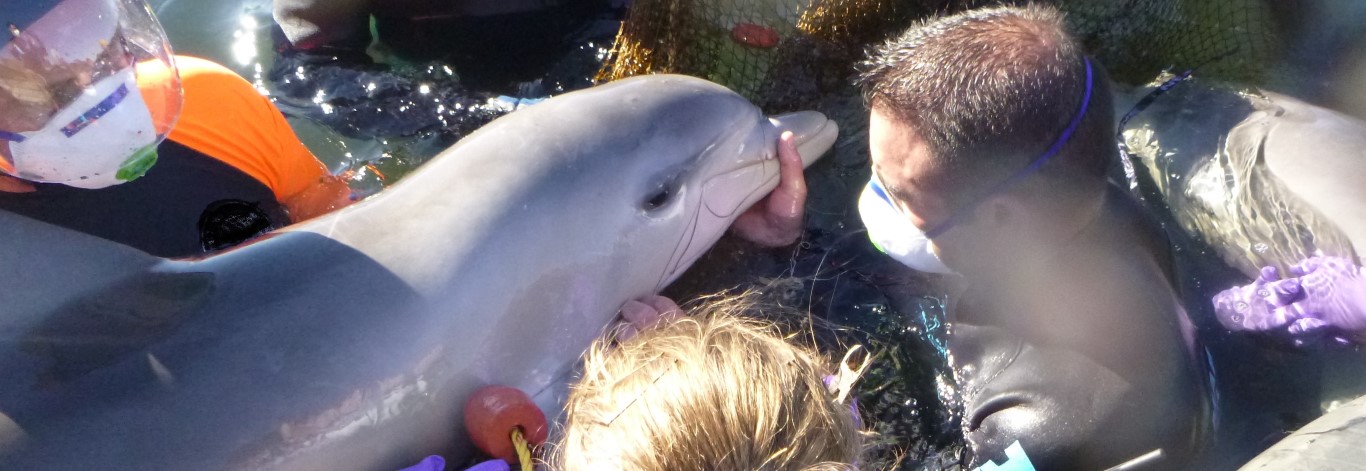

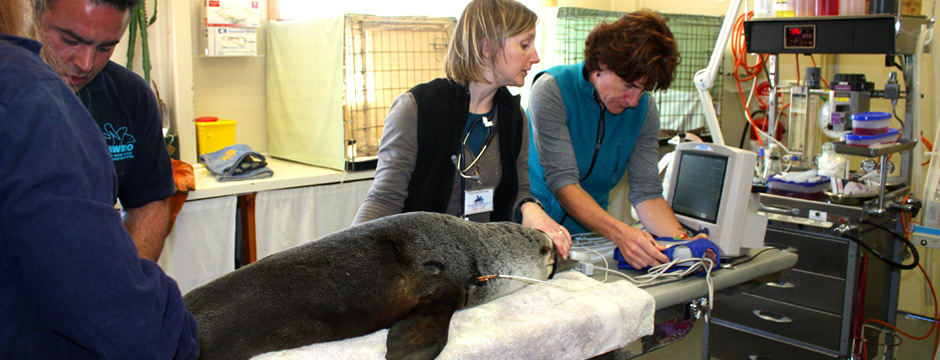
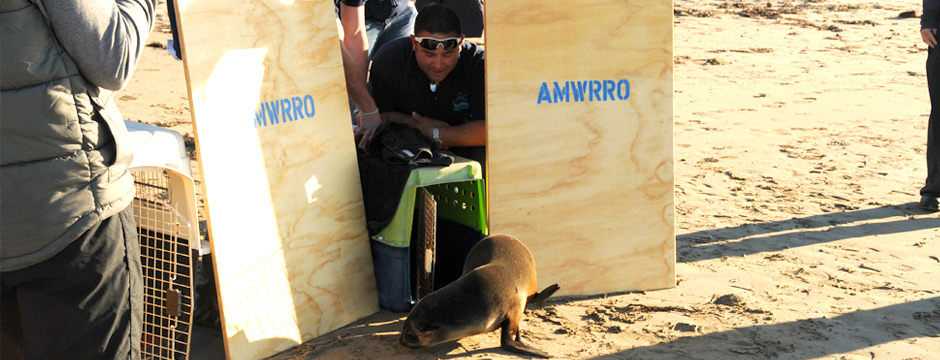
Australian Marine Wildlife Research & Rescue Organisation (AMWRRO), providing a rescue and rehabilitation service for our incredibly unique Australian marine wildlife species.
Found an injured marine animal?Unattended gill net fishing is still being allowed and is licensed within extremely sensitive wetland environments of which tens of thousands of Australian’s have been fighting to save and help preserve for years.
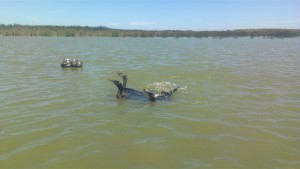
The Coorong and its associated lakes are home to tens of thousands of sea and shore birds, some native to Australia and other International visitors, all of which require protection and have a right to live a safe and non-human influenced life.The Coorong, Lake Alexandrina and Lake Albert and associated wetland environments are of upmost importance for the vast majority of Australians’ and cover a mammoth 140,000 plus hectares. These environments are of International importance so much so they are listed as a Ramsar Convention Wetland and have been since 1985.
Despite thousands of South Australians’ fighting for these lakes and wetlands to receive much needed inflows to maintain a healthy and sustainable ecosystem; our government departments responsible for issue licenses and setting rules and regulations within these areas in order to minimize the impact of fishing; still allow professional fishing activities to continue and of which have huge impacts on seabird and marine mammal species due to extremely relaxed rules, regulations and policing.
This fishery somehow managed to be crowned one of the very few “sustainable and eco-friendly” fisheries in Australia by the Marine Stewardship Council (MSC) and holds this accreditation for being noninvasive fishery to the environment.
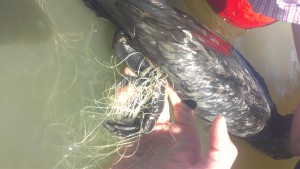
Great Cormorants leg entangled. Photos thanks to Mike and Sarah
However, AMWRRO has for many years been informed by many concerned boat users, kayakers and recreational fishers of the poor fishing practices that effect other wildlife that rely of these water to survive.
Last weekend AMWRRO was notified by two young people kayaking in the Coorong lakes that at least six Great Cormorants were found entangled in a single gill net that was set and left unattended. One of the birds had already perished and the remaining were still very much alive and in need of immediate assistance.
Despite being bitten several times these two young people worked for over an hour to free the birds and did so successfully. Advice was provided over the phone and a request for photographic evidence was also accommodated due to the difficultly surrounding visual evidence concerning poor commercial fishing practice.
One must ask: how this fishery was ever accredited by the MSC of which is an international fishery accreditation body for safe and eco-friendly fishing practice and furthermore, what must the said fishery do in order to be accredited with such an award and how does one police this accreditation once issued (if at all).
After reading through the MSC website, according to the “guidelines” associated with such an accreditation – this fishery is clearly in need of restructure and a close look at current fishing practices. It is our view that this accreditation should not be awarded to any such fishery that leaving unattended set nets and furthermore the MSC should consider ongoing independent policing of the said accredited fisheries that they accredit.
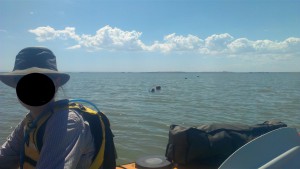
Dead Cormorants found in Gill Net. Photos thanks to Mike and Sarah
In AMWRRO’s view the overall accreditation should not be issued to any one fishery for more than 12 months and or, after any change of management within that said fishery, as oppose to the 5 year accreditation that currently stands.
In this instance the accreditation by the MSC has clearly failed to provide the general public and industries alike with peace of mind that “we the people” are purchasing a eco-friendly product and as a consequence should be removed immediately and not reinstated until such time as more “eco-friendly” practice are adopted and policed by an independent body within the said fisheries.
On the 6th March 2013 at 5:30pm AMWRRO was contacted by a concerned member of the public “Tim” who came across a sick looking seal at the states Lower South East region. Photos were requested so that we could get a better understanding of the animals overall condition. Images arrived shortly after and the animal was identified as a young Southern Elephant seal that required immediate attention.
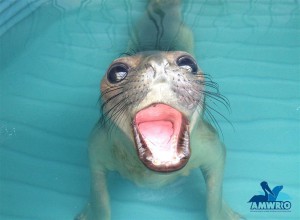
Elmo enjoying his swims and the odd squirt with the hose in his mouth
AMWRRO contacted the local Department for Environment Water and Natural Resources (DEWNR) Officer for assistance, yet when we were informed that he had already checked on the animal earlier that day and that it was “not able to move a muscle” and was “too far gone” in his opinion.
AMWRRO was then informed that the South Australian Museum were notified by DEWNR Officers and they were extremely interested in the animal as apart often their collection. As a consequence of the officers opinion he was considering “helping the animal on its way!” by way of firearm. AMWRRO disagreed and requested that no decisions be made until we were able to assess the animal more closely. This too was disregarded by the officer and was considered it a “waste of time and money” in his opinion.
AMWRRO then contacted the original caller Tim and requested he attend to the animal so that we could talk through its condition in more detail. Unfortunately whilst Tim was walking towards the animal he witnessed it making its way back to the ocean and swam off as a consequence of being harassed by young men.
AMWRRO knew this animal would return close to its original hall out location and contacted some “AMWRRO friends” who have assisted in the past to help relocate the seal. Within the hour the animal was located once again.
In the meantime; the DEWNR officer contacted AMWRRO in shock as the animal was not in the original location and that he thought it was unable to move and was half dead etc.
Now close to dusk several “AMWRRO friends” were closely watching this animal from a distance so that people and pet could be kept away until the sun had set.
The following morning AMWRRO dispatched its Emergency Rescue Crew (ERC) at 2am for the 5 hour long drive south and so the ERC would arrive on site at first light to assess the animals’ condition.
At first light the ERC arrived and assessed the animals condition, of which was nowhere near as bad as first explained by the DEWNR Officer. Nonetheless, the animal required attention and was rescued accordingly.
The ERC arrived back at AMWRRO with the young seal at 3pm. The animal was identified to be a young male approximately 2 years old, he was rehydrated and left to rest before being admitted into care the following day.
This young male Southern Elephant seal has since been named Elmo and is doing well considering. He is currently weighing in at 55kg and is extremely underweight. Once fully grown these animals can weigh up to 4000kg (4 tons) and dive to depths of 3 kilometres for up to 2 hours on a single breath. Southern Elephant seals are birthed at approximately 40kg and are weeded after 24 days; within such time these animals gain a mammoth 120kg+.
Flippers crossed this little (big) guy comes good with the treatment we provide and he is able to be released in the near future.
Unfortunately this situation is something that AMWRRO faces all too often and instead of utilising a state wide service such as AMWRRO that has been offered to DEWNR time and time again, this is yet another classic example of DEWNR arranging with another government department the carcase of an animal (that is not yet dead) to be added to its collection prematurely or without any consideration whatsoever.
Yet another life lost thanks to the DEWNR providing the wrong information to concerned members of the public after this young Australian sea lion walked into a caravan park and slowly died with no assistance whatsoever by the very department who is responsible for them.
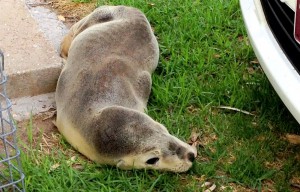
The young Australian sea lion left for dead in a caravan park by DEWNR Officers
This young and extremely emaciated Australian sea lion was exhibiting clear signs it required immediate assistance. Not only did the animal not move a mussel when approached, it was clearly malnourished and was suffering.
Concerned members of the public contacted the “authorities”, in this case the Department for Environment Water and Natural Resources who attended shortly thereafter. The officer (admitting to himself) he did not know much about these animals so did the right thing by contacting his superior for advice (who had work on the “marine parks” project); the advice that was given was to tell the concerned members of the public that its mother will return overnight to collect it and that “it was fine”. Considering this came from his superior the officer informed the member of public and left the animal where found (in a caravan park near a cabin).
The following morning this young Australian sea lion (a threatened species and the world’s rarest seal) was found dead in the same spot.
The advice that was given was not only wrong in every possible way concerning this particular animal; it just goes to show how little DEWNR really cares about such issues on ground.
Furthermore, the safety issues surrounding a potentially diseased animal sleeping and dying in a caravan park where adults and children alike eat, play and sleep clearly is something that was disregarded.
The body was collected by DEWNR the following morning.
If you find an injured marine animal or would like advice please feel free to contact AMWRRO 24/7